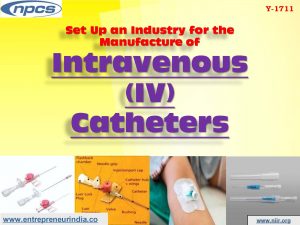Business Opportunities in Intravenous Cannula (IV) Production

Set Up an Industry for the Manufacture of Intravenous (IV) Catheters
Introduction
An IV Cannula, also known as an IV Catheter, is a Bevel-type needle that is used to make insertion smoother and less painful. This Catheter tube is flexible, kink-resistant, and double tapered with a rounded tip for a smooth introduction and minimal patient discomfort.
Intravenous (IV) cannulation is a venous access operation that involves inserting a cannula into a vein. Blood should be drawn and fluids, medications, parenteral care, chemotherapy, and blood products can be delivered into a vein.
Related projects:- Business Plan for Set up Manufacturing Unit of Intravenous (IV) Cannulas
Uses of (IV) cannula
An intravenous cannula is a flexible tube that can be placed into a patient’s veins to deliver drugs and IV fluids, as well as take blood samples. Intravenous cannula sizes are color coded according to their intended use.
The most popular cannula sizes are 14 to 24 gauges. Which cannula sizes should be used depends on the intent, the patient’s condition, and the urgency with which intravenous fluid must be administered. The smaller the gauge, the greater the cannula’s diameter, and the quicker the fluid flow.
Rapid is one of their most popular applications.
- replacement of fluid
- Transfusion of blood
- Major surgery and trauma
.
GOVT. Schemes for Promotion of Medical Devices Manufacturing
Medical devices have been listed as a priority sector for the flagship ‘Make in India’ initiative, and the Indian government is committed to strengthening the manufacturing ecosystem. India is Asia’s fourth-largest market for medical devices. The Indian market is currently heavily reliant on imports, but exports have recently increased.
India’s vision of being a global manufacturing center for medical devices is being boosted by the “Atma Nirbhar” Bharat mission. The Development Linked Incentive Scheme (PLI) and the Promotion of Medical Device Parks Scheme, for example, are recent initiatives that illustrate this. These schemes have been thoughtfully designed to encourage large-scale manufacturing and to provide the infrastructure necessary for the development of manufacturing clusters in India.
The PLI Scheme for Medical Devices Manufacturing proposes a financial opportunity to improve domestic manufacturing and attract substantial investment in medical device segments such as cancer care devices, radiology and imaging devices, anesthetics devices, implants, and so on. The production process during the scheme’s length, linked rewards worth up to INR 3,420 corer will be awarded. Surgical dressings and disposable perfusion sets are classified as Class A products by the central drug authority. If needles, urinary catheters, and other medical devices are classified as class B, bone cement, dialysis machines, and other medical devices are classified as class C due to the moderate-high risk they pose. Class D products, such as stents and heart valves, are high-risk. The low-risk, high-volume category has the most enforcement issues.
Related videos:- Disposable Products
The demand for consumables and patient aids is estimated to be worth $5.2 billion, or roughly 30% of the total. Large players dominate the hi-tech diagnostic imaging market, which would be the least affected. The government has set strict deadlines for the rule’s enforcement for various items. The notice from the Ministry of Health includes all products, including instruments, apparatus, appliances, implants, materials, and other objects — whether used alone or in combination, including software or an accessory — that the manufacturer intends to be used specifically for humans or animals.
The announcement comes at a time when the domestic medical device industry was anticipating a separate law to govern medical devices, rather than the existing regulation that classifies such devices as “drugs” and requires regulatory approval under the Drugs and Cosmetics Act.
Market Outlook
The market has been divided into three categories based on the material used in the construction of cannulas:
- Metal
- Plastic
- Silicone
In the cannula market, silicone material is expected to be the fastest growing segment. The non-irritant quality of the material is a major factor moving the silicone cannula market forward. Furthermore, since this form of cannula is more flexible and delicate, it is more convenient and manageable for both the health care professional and the patient to use. The cannula market is divided into four segments based on geography: North America, Europe, Asia Pacific, and the Rest of the World. The cannula market is divided into four segments based on geography: North America, Europe, Asia Pacific, and the Rest of the World.
Market Research; – Market Research Report
Boston Scientific Corporation, Teleflex Incorporated, Conmed Corporation, Sorin Group, Edward Life science Corporation, Medtronic plc. Terumo Corporation, Smith & Nephew plc. Smiths Medical, and Marquette Holding B.V. & Co. are among the major industry players in the cannula market. KG. The global peripheral intravenous (IV) catheter market is projected to hit USD 6.73 billion by 2025, up from USD 4.03 billion in 2017. The market is expected to expand at a CAGR of 6.1 percent from 2018 to 2025.
KEY PLAYERS:-
Angi Plast Pvt. Ltd.
Global Medikit Ltd.
Hemant Surgical Inds. Ltd.
Hindustan Syringes & Medical Devices Ltd.
Mediplus (India) Ltd.
Smiths Medical India Pvt. Ltd.